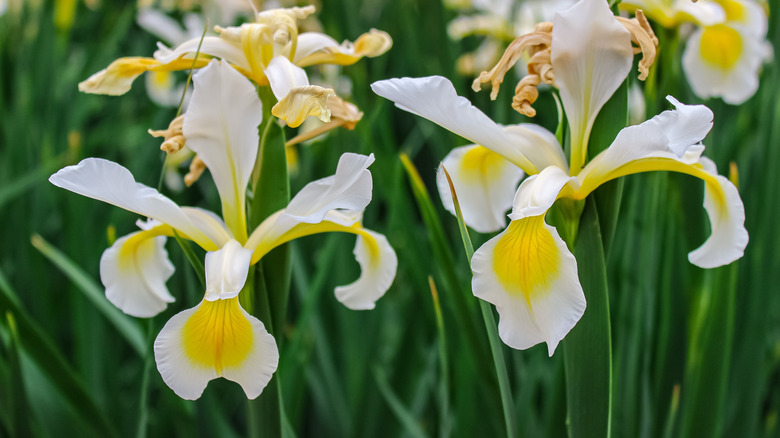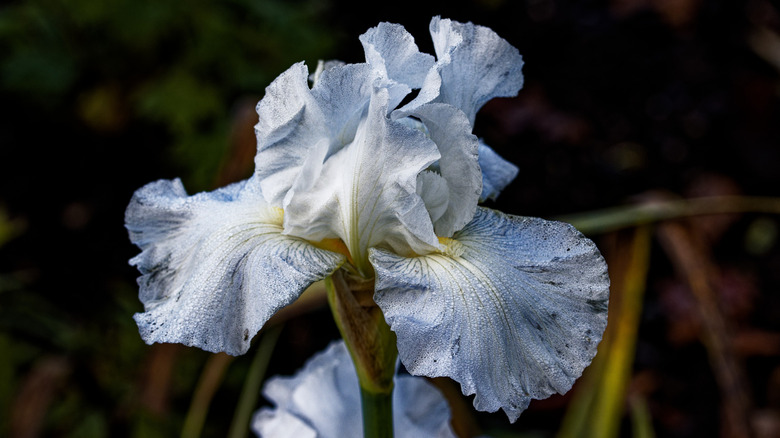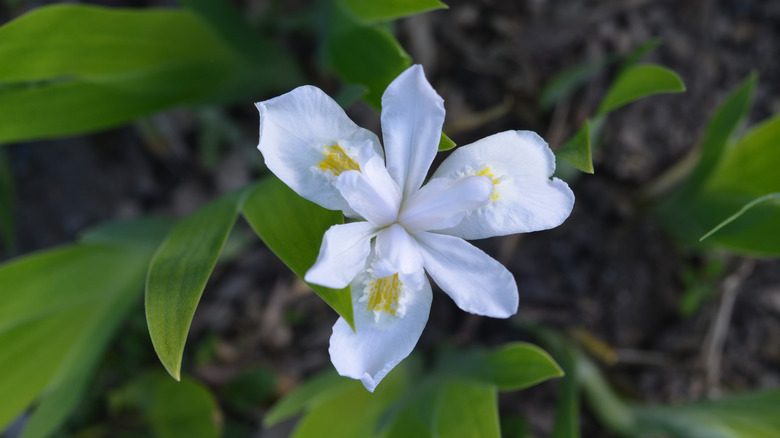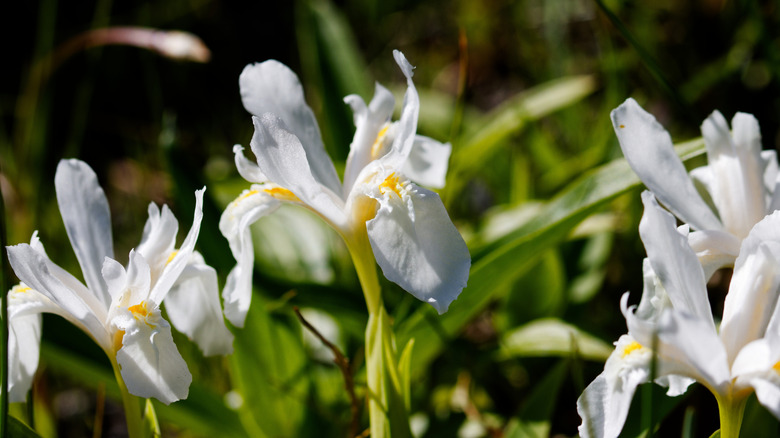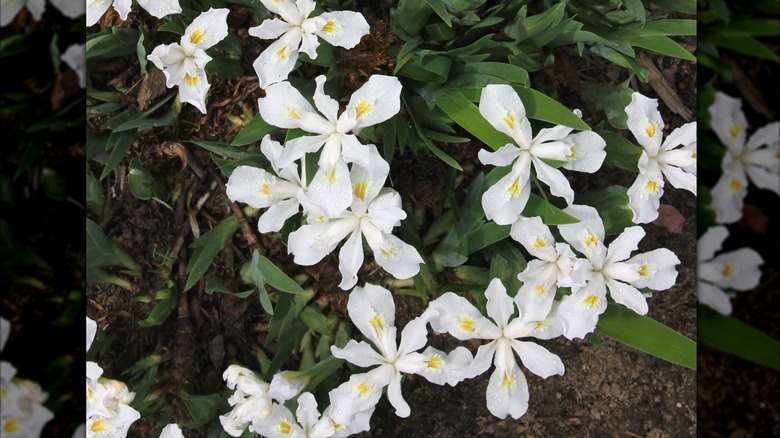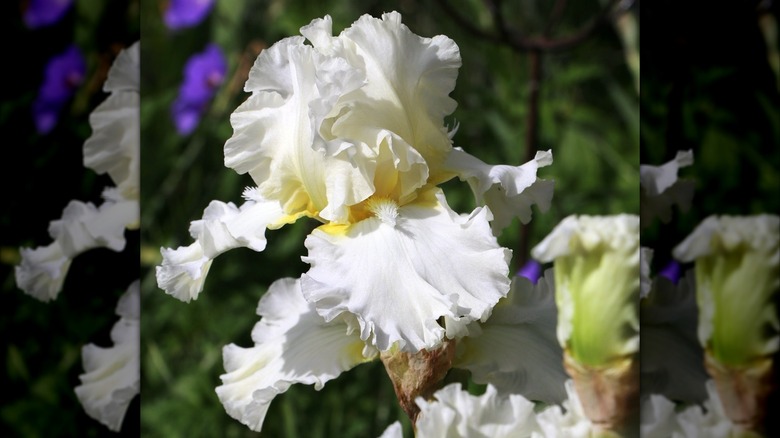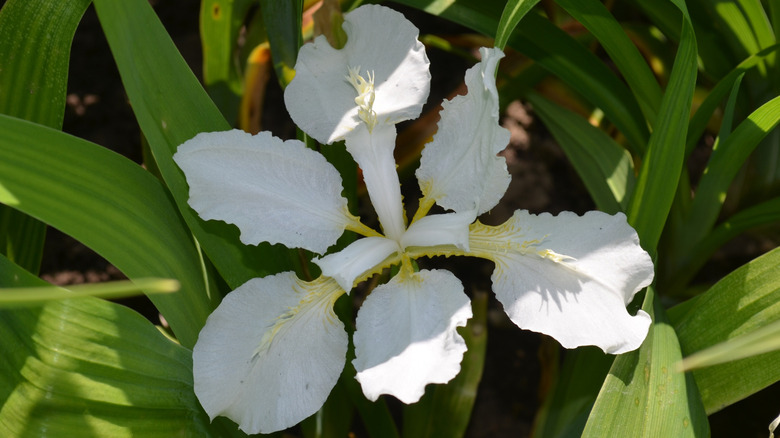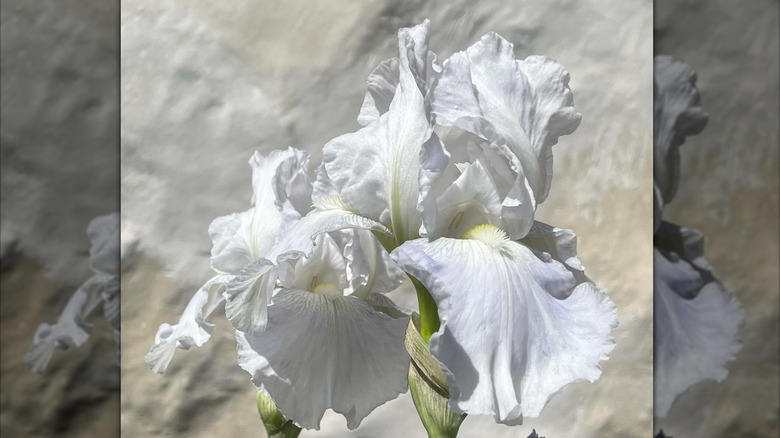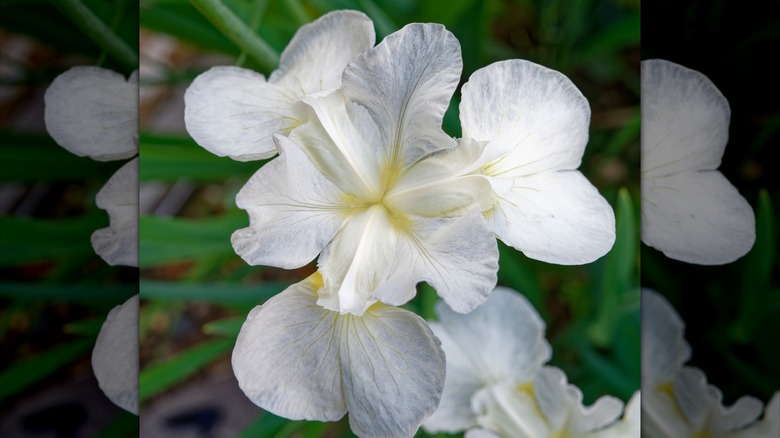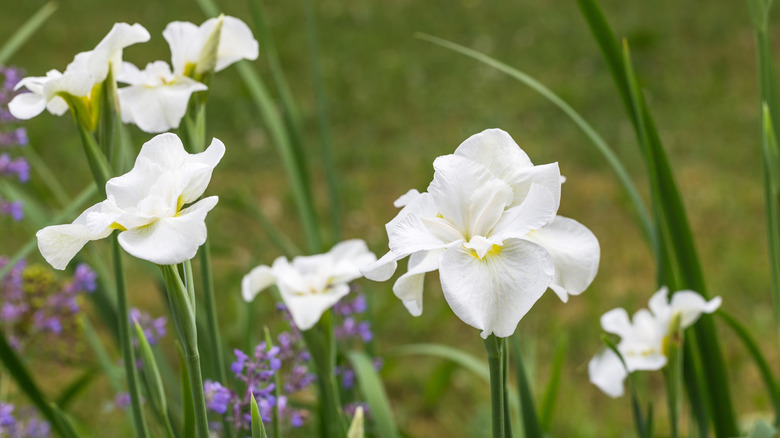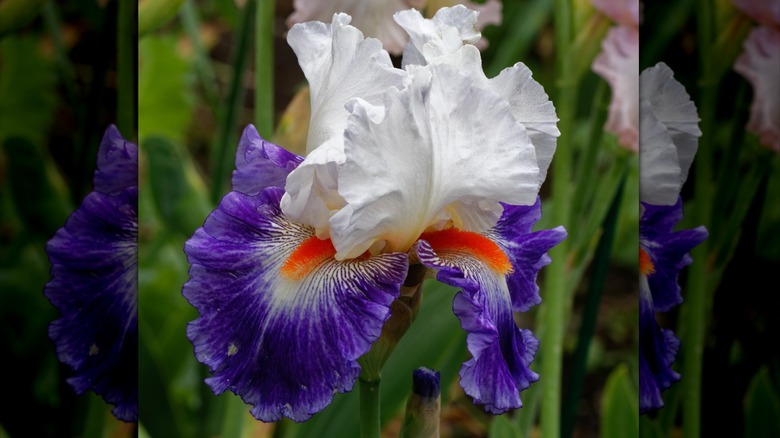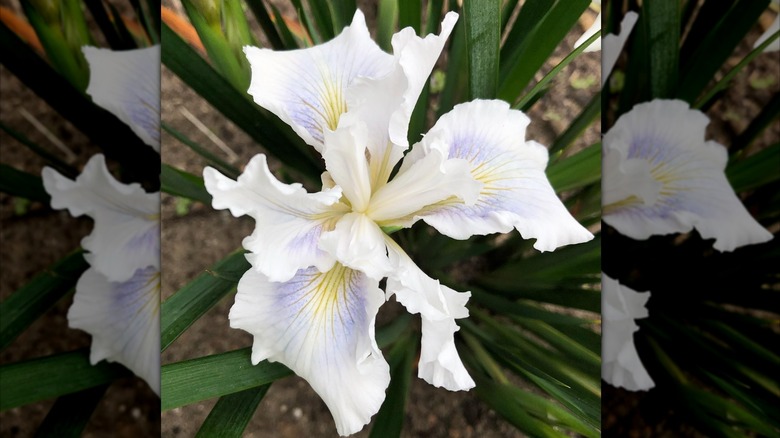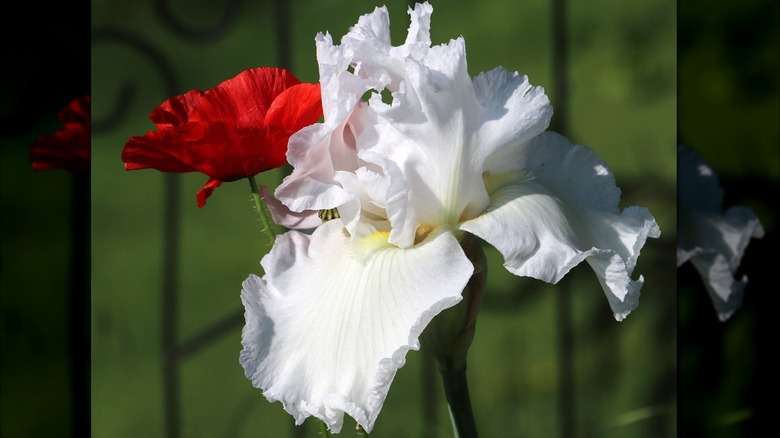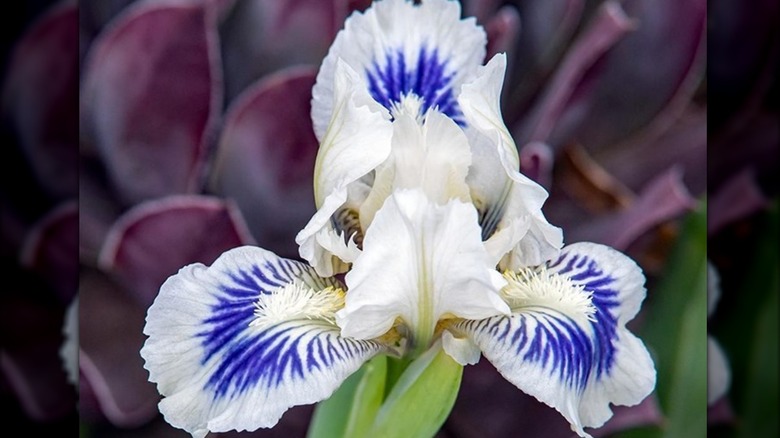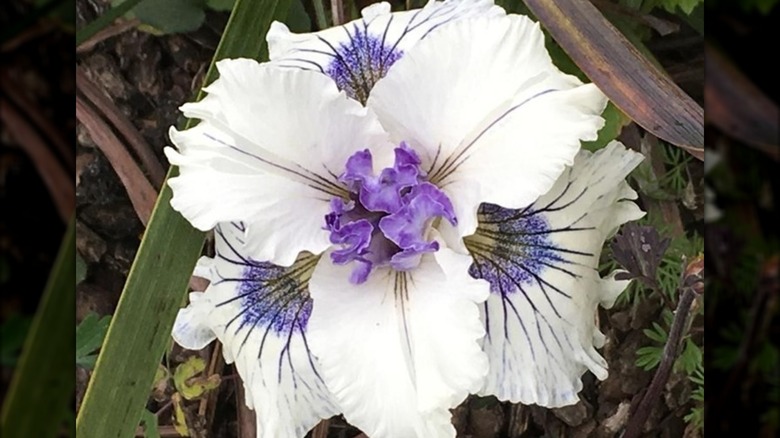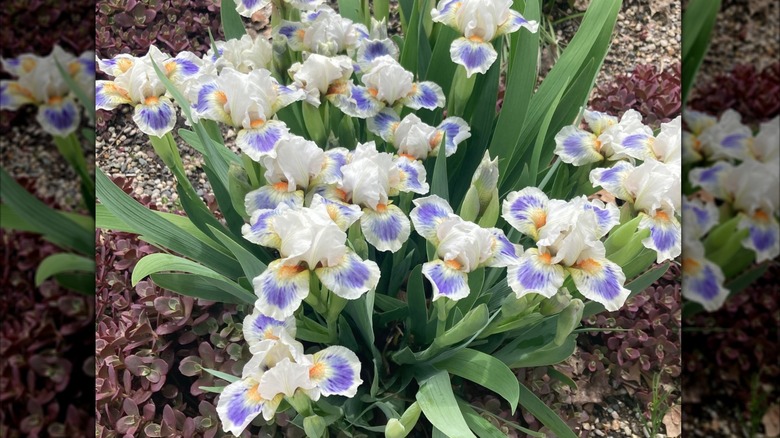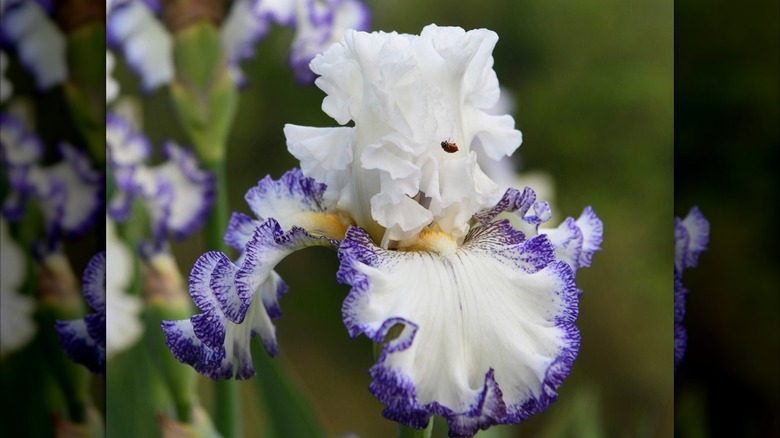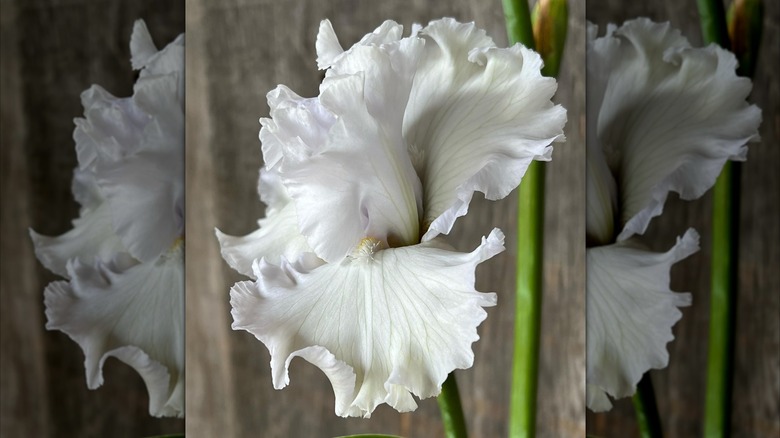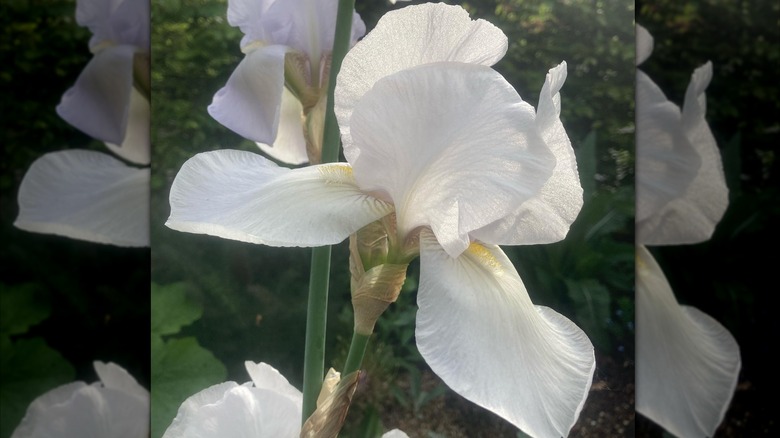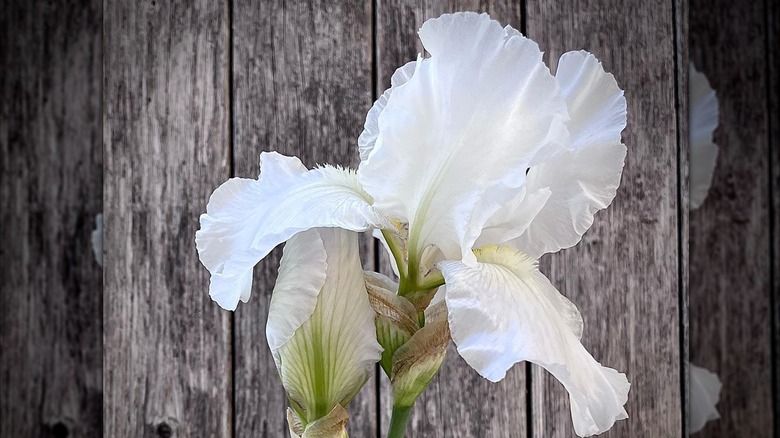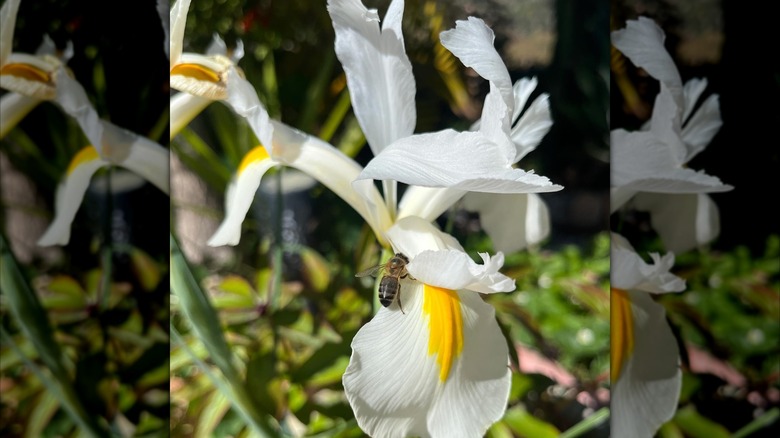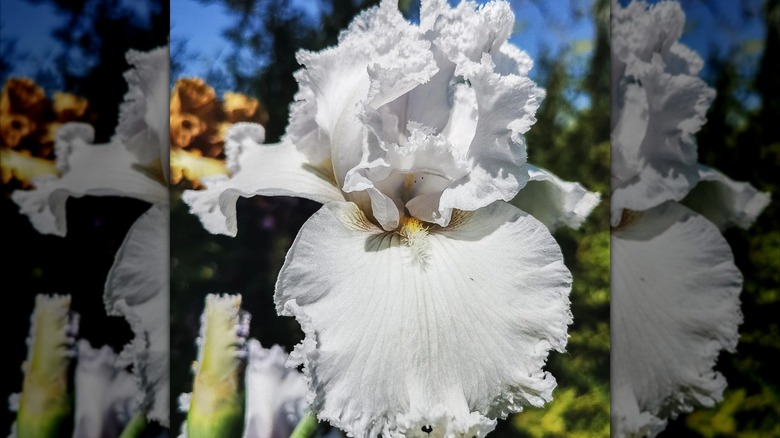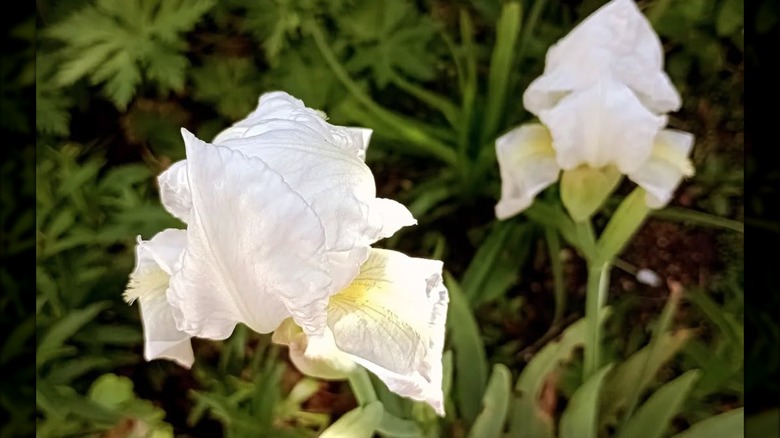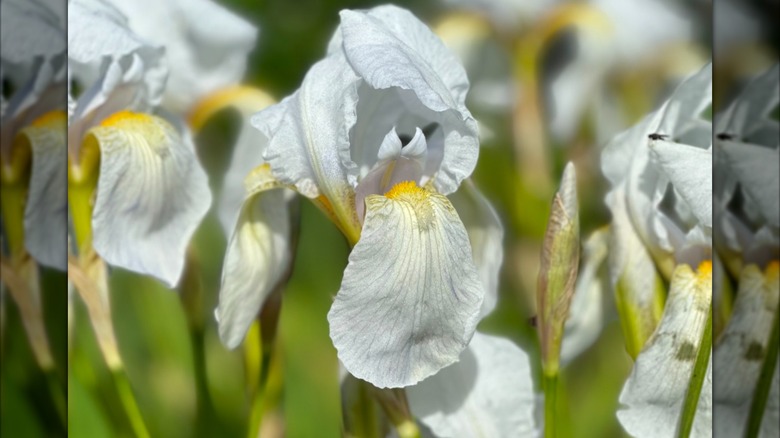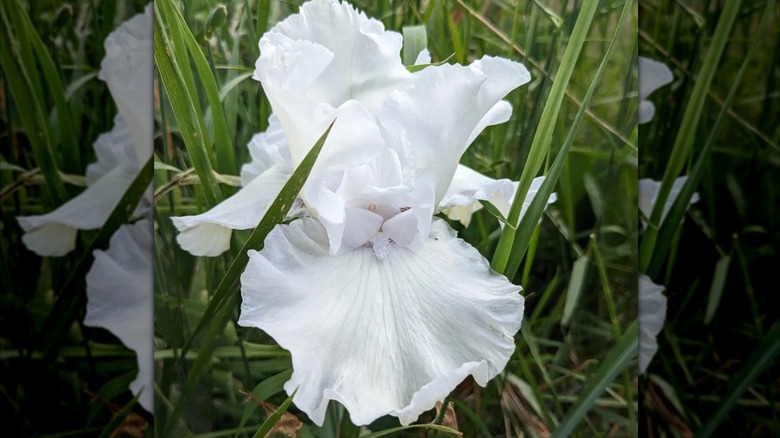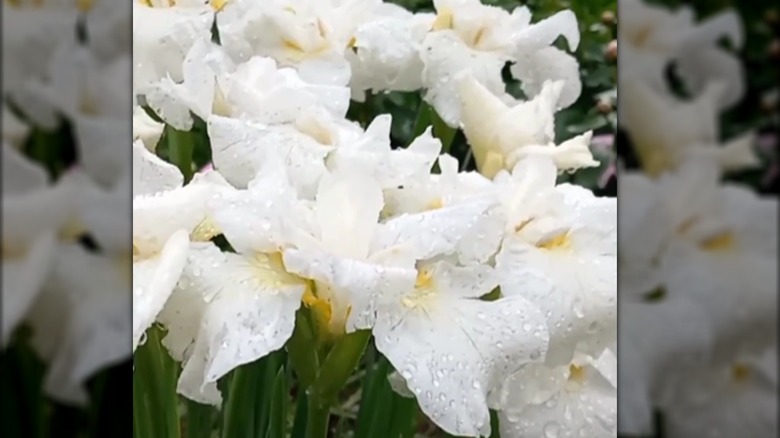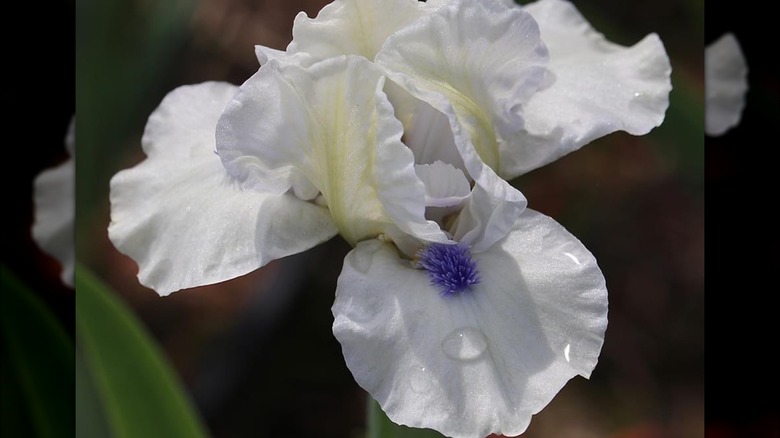27 Beautiful Varieties Of White Iris Flowers (& Tips For Growing Them)
No kaleidoscope of color can inject as much elegance or grace into a garden as white Iris flowers do. Symbolizing purity and innocence in Japanese culture, white Irises have become a standout in wedding décor and cut gardens for their precious blooms. Better yet, they're a staple in minimalist or themed landscapes, including night gardens, moon gardens, and Zen gardens, where their pristine petals reflect the light. Besides, they play a key role in cottage and pollinator gardens, where they're appreciated by butterflies and hummingbirds.
But considering their immense diversity — the Iris genus alone has over 300 species, in addition to several sports and hybrid cultivars — choosing a white Iris variety for your garden can be a tad difficult. You could either stick to the tall bearded varieties, or the smoother, beardless options, like Siberian, Japanese, or the group of Pacific Coast native Irises. To simplify your decision, we've listed 27 of the most captivating white Iris flower varieties and tips for nurturing them.
Iris 'Immortality'
Since its introduction in 1982, Iris 'Immortality' has carved a place for itself in sunny garden beds and borders. That's because its ruffled petals first bloom during spring's transition into summer and again around fall. Since it's a cultivar of tall bearded Iris, it has similar requirements of full sun and humus-y, well-drained soils in zones 3 to 9. However, you'll have to keep the 2 1⁄2-foot-tall plant watered and re-fertilize it during the summer to encourage a second flush. If you'd rather enjoy their lovely fragrance from containers, plant them during spring.
Dwarf crested Iris
Dwarf crested Iris (Iris cristata) is a low-growing perennial that beckons spring with its yellow-crested white petals. It even attracts bees, hummingbirds, and butterflies inside your garden. When not in bloom, it establishes itself as a deciduous ground cover that deer dislike. Dwarf crested Iris prefers partial shade but will tolerate full sun with more watering. Avoid growing this variety in excessively fertile soils, as they interfere with blooming. It's native to the north-central and the eastern U.S. region, and cold hardy in zones 3 to 9. Its sap and seeds are toxic and cause skin irritation.
Iris 'Alba'
No shade — partial or heavy — can diminish the yellow-crested white beauty of the Iris 'Alba' as it blooms during spring. Nor does it lose its standing in shallow waters or boggy areas in zones 3 through 9. Easily started with seed, Iris 'Alba' thrives as a fast-growing ground cover that attracts hummingbirds and pollinators in organically rich soils with good drainage. Separate the rhizomes in the fall to expand the lanceolate green carpet. Its sap, seeds, and roots can be mildly irritating on the skin and toxic on consumption.
'Eco White Angel' crested Iris
Grow 'Eco White Angel' crested Iris to add mid-spring interest to your moon or fairy garden. Spaced 10 inches apart, 'Eco White Angel' forms a deer-resistant, low-growing ground cover that may rise 8 inches high when decked by its mass of yellow-centered, creamy white flowers. Maintain its planting medium on the drier side and expose it to morning sun for the best blooms. It's hardy in zones 3 through 8 and can survive for a decade in an optimal growing environment.
Iris 'Devonshire Cream'
Mark the spring season's finale by growing another cultivar of tall bearded Irises: 'Devonshire Cream.' Crossbred by George Sutton, 'Devonshire Cream' is prized for its highly ruffled appearance and has received the Award of Merrit in 2004. Its imbricated, lemon-mottled, creamy white petals atop purplish-green foliage impart the area with a spicy aroma. Grow it in sites receiving six hours of direct sunlight for the best performance, though it does tolerate some shade. It's hardy in zones 3 through 9.
Japanese roof Iris
Japanese roof Iris (Iris tectorum) also supports 6-inch-wide, near-tubular white (or lavender) flowers atop its 1-foot-tall green clump. Since its ribbed leaves point down, Japanese roof Iris is best grown as a ground cover. However, it'll take a long time to mat out, unless you separate its clumps in the fall to accelerate the process. Japanese roof Iris is highly tolerant of wet soils and can be mass planted around water features like ponds. It's hardy in zones 4 through 9 and is best grown in sunny or partially shaded sites.
Iris 'Mesmerizer'
As a mid-spring bloomer, Iris 'Mesmerizer' will enrapture you with its white frilly flowers as they grow out of muted green, button-shaped poms. Besides, they put out a second flush in favorable conditions, especially in the warmer climates of zones 6 through 9. That said, they are hardy in zones 3 to 9. These Irises are best grown in locations with full sun, but partial shade may still enable them to bloom.
Iris 'White Swirl'
Desire Iris plants that will flood your rain garden with abundance? Look for 'White Swirl,' a cultivar of the Siberian Iris. It marks the spring's transition into summer by blooming yellow-throated, ivory-white ruffled flowers. Other times, it maintains ornamental interest through its lance-like, bright green foliage, provided you keep watering the perennial even after it has exhausted all blooms. In the northern ranges of its adaptive zones 3 to 8, its rhizomes can be planted in spring or summer, while fall planting is best in southern regions. Deadhead and the plant to improve flowering.
Iris 'Gull's Wing'
Available since 1989, Iris 'Gull's Wing' is a beardless variety of the Siberian Iris that adds late spring interest. It's popular in landscapes for its pure-white arching petals that are broader than its Iris peers can muster. Its bluish-green foliage is equally attractive — not to deer and rabbits, though — serving double duty as a decorative ornamental grass in zones 3 through 8. It's one of those beautiful plants that will thrive in clay soil or wet conditions if full sun exposure is provided. This cultivar is relatively pest and disease resistant.
Iris 'Gypsy Lord'
Add a touch of blue and red mid-spring to your white Iris collection with 'Gypsy Lord,' a cultivar of bearded Iris. While its lower petals are bluish-purple with a lone white patch, the upper petals are wholly white and punctuated by paprika beards. The award-winning, semi-evergreen perennial can grow 4 feet high and half as wide, so you can use it to add vertical interest to sunny sites in zones 3 through 9. Slightly acidic, sandy, and loam-textured soils are ideal. Maintain good drainage to keep rot at bay.
Del Norte County Iris
Indigenous to parts of Oregon and California, Del Norte County Iris (Iris innominata) is another Iris variety that supports diverse colors, including white. The brown or deep purple veins on its white blooms end in yellow throats, directing pollinating insects to the stamen. The Pacific Coast Iris plant is quite compact, maturing at under 10 inches in height, though its red-marked, glossy evergreen leaves can measure slightly bigger. It's cold tolerant to 20 degrees Fahrenheit and prefers partial shade over full sun. Propagate this Iris using cuttings because its seeds can cross-hybridize with other varieties.
'Arctic Age' Iris
Hardy through zone 3, 'Arctic Age' Iris is another tall bearded cultivar worthy of your consideration. Even when not flowering, it sprouts a dense mound of green foliage (no bare stems), making it suitable for fronting borders. From mid-spring and into summer, its classic white, lemon-bearded flowers extend the plant's height to 4 feet. Although the perennial is typically unfussy about soil conditions, it prefers moist soils paired with full-to-part sun exposure. Space it 18 inches apart when mass planting in beds or pop in containers.
Iris 'Water Goblins'
Embellish your small spaces with Iris 'Water Goblins,' a miniature dwarf bearded Iris variety hybridized by Paul Black. This enhanced version of dwarf Iris (Iris pumila) maxes out at 7 inches. The cultivar's white flowers are fairly dainty as they unfurl mid-spring, showcasing their unique violet-blue streaks along the lower petals. To enjoy their musky aroma, plant 'Water Goblins' in a spot with full sun exposure, though they'll withstand light shade. They're cold hardy to zone 3 but won't adapt to the heat beyond zone 8.
Pacific Coast Iris
Award of Merit 2024 winner, Pacific Coast Iris (Iris 'Big Waves') is an attractive mid-season blooming variety you might want to plant. It's creamy white all over, save for the blue veins that run along its petals, terminating in bluish-purple pollinator signals. This Iris is compact, too, growing slightly higher than 15 inches. It's best grown in zones 4 through 8 in moist, well-draining soils. However, it might require soggy conditions when it's actively blooming. While it can withstand impoverished soils, high alkalinity a no-no. This Iris grows in full sun to part shade.
Iris 'Alas'
Looking for beautiful perennials for your sunny rock garden? Enter Iris 'Alas'. This miniature dwarf bearded variety won the Award of Merit in 2021 for its beautiful mid-spring display of white standards and green- or blue-patched falls with orange beards. Since it tops out at 7 inches, it fits right into constricted spaces. This also means they won't flop over after a downpour. Sometimes, they grow four falls instead of the typical three, making them a must-try. They're hardy in zones 3 through 8 in sunny and partially shaded sites.
Iris 'Bright and Shining Star'
Invite ladybugs into your yard by growing Iris 'Bright and Shining Star,' another tall bearded cultivar with a spicy fragrance. This white-blooming perennial is the star of a garden with its gold crests and smoked purple stripping along the edges of the falls. They're highly adaptable to most soil conditions, even thriving in alkaline soils (up to pH 8.5). However, these Irises despise wet feet and require more fertilization if the soil is poor. Full sun exposure is ideal, though they'll put out a decent performance with partial shade in zones 4 to 8.
Iris 'Jimmy G'
Turn the sunniest patch of your yard into a silvery-white cloud with the Iris 'Jimmy G.' It's a mid-spring bloomer with a very complicated heritage but considered a tall bearded Iris cultivar. However, the cross-hybridization pays off well, since it has an outstanding branching structure and highly ruffled petals that sometimes appear a pale lilac. It grows quite tall to over 40 inches in hardiness zones 3 through 9. Iris 'Jimmy G' might tolerate partial shade and alkaline soils, but scorns waterlogged or marshy conditions. When mature, this Iris exhibits light drought resistance.
Iris 'White City'
Introduced in 1939 by Olive Murrell, Iris 'White City' is a historic bearded cultivar that initially opens a muted blue but progressively turns a silken white with lemon beards, adding an icy-cold touch to its surroundings. However, it also breathes a sweet fragrance into the area, attracting bees from spring's end to early summer. Its deciduous clumps can reach heights of 35 inches, tipping them to the middle of mixed borders. Since it enjoys light, sandy soils, you can also grow it in gravel gardens. Give this Iris full sun exposure and potash-heavy fertilizer in spring.
Iris 'Frequent Flyer'
Imagine a ruffled Iris so white it almost looks translucent despite its light-yellow beards. Or a variety that blooms multiple times throughout the year, starting in early spring with repeat shows lasting into fall. That's 'Frequent Flyer' for you — another spin on the bearded Iris variety. However, such re-blooming is limited to zone 5, even though it's hardy in zones 3 to 9. You might also appreciate its deer-resistant, gray-green foliage that stands 32 inches tall. Grow 'Frequent Flyer' in full sun, or light shade in warmer climates. It prefers alkaline soils.
Iris magnifica
Otherwise known as Juno Iris, Iris magnifica is another late blooming, bee-friendly iris variety. It sports lavender-tinted, white falls that end in frilly wings. It can brave temperature drops to –20 degrees Fahrenheit sans any snow cover. It also breaks no sweat when the mercury touches 100 degrees Fahrenheit. You can grow Juno Iris through seeds or rhizomes, but be mindful about gophers getting to its roots. It has volunteer seedlings in the spring. Ensure good drainage and full sun. The Iris magnifica 'Alba' cultivar promises an astonishing, pure white form.
Iris 'Queen of Angels'
Iris 'Queen of Angels' is one of the many plants you need to create the perfect secret garden getaway, for its lacey Victorian glory can't be missed. While it only starts blooming toward the end of spring, its lilac-tinted, filigree white petals marked by muted yellow beards are a sight to behold. Besides, it's cold tolerant to –40 degrees Fahrenheit and thrives in full to partial sun exposure in zones 3 through 9. It'll grow around 36 inches tall. 'Queen of Angels' is drought tolerant after establishment and prefers well-draining soil.
Iris 'Riveting'
Paul Black's 2009 introduction, Iris 'Riveting' will floor most gardeners with its ruffled, mid-season blooms. 'Riveting' is mostly white, save for the huge inky purple blobs on its falls and yellowish-white beards. It also perfumes the landscape with an unmistakably spicy fragrance. As can be expected from dwarf cultivars of bearded Irises, 'Riveting' maxes out at 15 inches. Plant it in the fall, in sites receiving six hours of direct sunlight. However, if required, it will endure some shade. It's hardy in zones 3 through 8 and should be spaced over 12 inches apart in flower beds.
White cemetery Iris
White cemetery Iris (Iris albicans) is an heirloom variety. It has been passed down for generations because of its pristine white form, green veins, grayish foliage, and unique branching. However, it isn't tough, with buds freezing and resulting in a no show if spring temperatures dip below 28 degrees Fahrenheit. Despite being hardy in zones 4 to 8, it's best suited to the milder climates of Gulf Coast states. In the colder reaches of its growing range, you must protect this Iris from frost. Since it isn't water-hungry, grow it in dry soils with full sun exposure.
Florentine Iris
Make your flower beds or borders smell like violets by growing Florentine Iris (Iris 'Florentina'). This perennial supports blue-flushed white petals from late spring through summer. Removing spent blooms and regular watering during peak summer may induce reblooming in the fall. As this Iris is susceptible to rot, offer it good drainage, either by growing it in raised beds or amending the soils (especially clay) with gypsum. It's hardy in zones 3 through 9, and the best display occurs in full sun in rich, loamy soils. Fertilize it in early spring and after the first flush.
'Got Milk' bearded Iris
Aitken's 2002 introduction and 2006 Award of Merit winner, 'Got Milk' bearded Iris is a vigorous variety that adds elegant, late spring interest to gardens in zones 4 through 9. Its milky white petals with barely noticeable yellow tinges fan out atop glaucous foliage that deer loathe. Plant the rhizomes near surface level in areas receiving five hours of direct sunlight for adequate growth. Although it can survive in clay and sandy soils, good drainage is a must. The plant may die in severe winters without mulch protection.
Siberian Iris 'Swans in Flight'
Use Siberian Iris 'Swans in Flight as an early summer nectar treat for bees and hummingbirds while you enjoy its graceful, yellow-toned, ivory-white ruffled petals. With copious watering, they flourish in full sun sites but will need some shade in the lower ranges of their adaptive zones 3 through 9. Separate the clumps (either in fall or spring) when its performance grows sub-par. They favor acidic soils with pH between 5.2 and 6.4. They grow over 30 inches tall and 24 inches wide and can be massed in rain or cottage gardens.
Iris 'Bluebeard's Ghost'
Iris 'Bluebeard's Ghost' is a multiple award-winning, 14 ½-inch-tall introduction from the Mid-American Garden. It's known for its riffled, pure-white flowers overrun by green veins and indigo beards that reflect off its falls, creating an enchanting display mid-spring. In zones 3 through 8, grow 'Bluebeard's Ghost' in south-facing courtyard gardens, borders, coastal strips, or containers to enjoy its mild, sweet fragrance. Provide well-draining, sandy or loamy soils. Deadhead and cut back the perennial in the fall and divide the plant every three to four years when the beds grow overcrowded.
